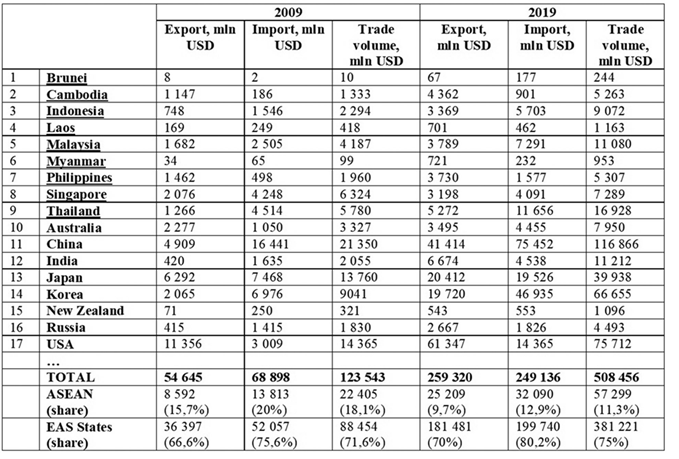
Полная версия
Регионы в современном мире: глобализация и Азия. Зарубежное регионоведение
The authors argue that owing to increased competition between the great powers with potentially disturbing implications for Southeast Asia, the on-going Vietnam’s chairmanship becomes a crucial point in ASEAN’s history. Grasping the challenges, the association has to deal with, as the present ASEAN chairman Vietnam offers its ASEAN partners, as well the external powers, an agenda of cooperation with a clear consolidating component.
The novelty of the study stems from a cutting-edge research of Vietnam’s likely policy directions as the present ASEAN chairman, which is based on an analytical interlink between the changes of the international milieu in Southeast Asia between 2010 and 2020, ASEAN’s remedial measures and their Vietnam perspective. In line with this analytical focus, a deep and nuanced assessment of the SRV’s priorities and policy directions as the ASEAN’s 2020 chairmanship is made. Findings on this set of issues add the practical relevance of the study and make it academically unique.
Keywords: Vietnam, ASEAN, South East Asia, Asia Pacific, Indo-Pacific, South China Sea, security, cooperation.
Introduction
The effective chairmanship in the Association of Southeast Asian Nations (ASEAN) is considered by the leadership of the Socialist Republic of Vietnam (SRV) as one of the main foreign policy tasks for 2020. The midterm review of the ASEAN Community Vision 2025 and the 25th anniversary of Vietnam’s accession to the Association add urgency to this priority. The reputation aspect also matters – the election of Hanoi to the post of the nonpermanent member of the UN Security Council for 2020-2021 and the SRV’s chairmanship in ASEAN are convincing indicators of an increased role of the state on the regional and the global arena. To examine the ASEAN direction of Vietnam’s policy between the previous (in 2010) and the on-going SRV’s chairmanship in ASEAN becomes a timely and relevant exercise.
The chapter starts from a review of international context in Southeast Asia between 2010 and 2020. Then it turns to examining Vietnam’s contribution to ASEAN’s policy to cope with the emerging challenges. The priorities of Vietnam’s on-going ASEAN chairmanship are considered through the prism of these developments. The conclusion summarizes the main findings of the study.
A Decade of Changes
Between two Vietnam’s chairmanships, Southeast Asia has seen profound international changes. In 2010, the region and the world had barely recovered from the global financial crisis. ASEAN’s policy demonstrated that in a critical situation, the ten states prefer to act separately rather than collectively47. This, in turn, decreased ASEAN’s ambitions to solidify its status of the driving force of the Asia-Pacific. From the Vietnam perspective, a task to confirm the validity of the Association’s ambitions, as well as to provide ASEAN with a new reputational value, was pressing. On the whole, that task was fulfilled. The main results of Vietnam’s chairmanship included the expansion of the East Asia Summit through the accession of Russia and the United States and the launch of the ADMM Plus format.
Vietnam’s 2010 chairmanship saw Washington’s involvement in the South China Sea issue, including the Sino-American polemics at the ASEAN Regional Forum48. These moves were welcomed by Vietnam and a number of ASEAN states seeking the US’ support in opposing the PRC49.
Significant progress has been achieved in relations between ASEAN and its extra-regional partners. Specifically, the involvement of non-ASEAN countries in the regional affairs has radically changed – some of them actually started to set the tone for the evolution in Southeast Asia. China launched the Belt and Road Initiative, which aims to provide large-scale financial injections into ASEAN countries focusing on, but not limited to, the development of their infrastructure. Japan responded by the “Partnership for Quality Infrastructure” (hinting at the “poor-quality” Chinese), further politicizing economic cooperation. The US Republican Administration brought a second wind to the Quadrilateral Defense Cooperation (Quad) (USA, Japan, India, Australia) and introduced the “Indo-Pacific” narrative. Simultaneously, Washington created the “Blue Dot Network”, with the focus upon the infrastructure development. Lastly but importantly, extra-regional actors intensified their polities, from both substantial and institutional perspective, in the Mekong River basin.
As for the South China Sea, the assertiveness of Beijing in the maritime area did not weaken. The issue is perceived as one of the most important regional security challenges, while the international pressure on the PRC over it also increased radically.
In the economic sphere, a trend toward protectionism and a wider use of non-market regulatory methods has become widespread in the international politics. This could not but alert ASEAN, because the success of the export-oriented economies of its member states countries crucially depends on the free access to the external markets.
In general, the involvement of non-ASEAN countries in Southeast Asian affairs has increased while the launch of competing mega-projects has become a disturbing development for the Association. The initiatives of the great powers objectively began to “outweigh” ASEAN projects. The aftereffect is a decrease in the importance of ASEAN dialogue platforms, undermining ASEAN’s neutrality and central role in the Asia-Pacific multilateral cooperation. Lastly but importantly, understanding the complexity of intra-ASEAN processes, some non-regional players increasingly began to develop cooperation with individual ASEAN member states rather than with ASEAN as an international actor, which further intensified downward trends in the association.
At these complicated crossroads, ASEAN is forced to act very carefully. Though ASEAN was virtually unable to develop an effective approach that could consolidate the interests of great powers, it has not lost the role of a central negotiating platform in the region. In the context of the changes that have taken place over the past decade, this is an achievement in itself. And although the Association was unable to elaborate on instrumental links between its prospective plans and the Belt and Road Initiative, it was able to formulate its Indo-Pacific Vision50, which is also notable success.
In the economic sphere, due to the different level of economic development of its member countries, ASEAN could not ensure completely free movement of goods, services and capital in Southeast Asia. At the same time, the establishment of the ASEAN Economic Community has spurred the launch of specific projects to strengthen infrastructure interconnectivity.
These factors suggest that the association has been relatively successful in coping with the decade-long challenges and associated risks which have been steadily rising. At this juncture, the role of chairmanship of a specific country, in terms of both its priorities and possibilities to translate them into reality, comes to the fore.
The Vietnam Perspective
Since 2010, Vietnam has been one of the most active ASEAN member countries in promoting the maintenance of ASEAN’s internal solidarity, regional resilience, common values, standards of conduct, as well as strengthening its central role in the Asia-Pacific multilateralism.
Beside the already discussed expansion of the EAS and the launch of ADMM Plus, Hanoi continued to engage non-regional partners in the dialogue in order to keep the Southeast Asian security challenges manageable. For example, Vietnam promoted ASEAN joint maritime drills with China in 2018 and with the United States in 2019. In the same strain, Hanoi is likely to make efforts to conduct similar drills with Russia in the year of its chairmanship51.
On the South China Sea issue, Vietnam’s policy aimed to achieve a consensus within ASEAN, as well as between ASEAN and its extra-regional partners. As a result, in May 2014, the foreign ministers of ASEAN issued a separate Statement on the South China Sea, for the first time since 199252.
The results of Vietnam’s involvement in the economic regionalism are dubious. In line with creating a network of free trade agreements with partners around the world, Hanoi, although it has markedly increased the volume of trade with nine partners in the Association, in percentage terms the ASEAN contribution to Vietnam’s foreign trade decreased from 18.1% to 11.3%, while the share of the East Asia Summit countries increased from 71.6% to 75% (See Table 1). But as practice demonstrates, for extra-regional states an FTA regime with Vietnam often becomes the first step for launching negotiations between non-regional partners with other ASEAN states and eventually for concluding an FTA with the Association.
Table 1. VIETNAM’S TRADE WITH EAS STATES IN 2009 AND 201953

Increased investment from both ASEAN and EAS members in Vietnam’s economy deserves mentioning. While in 2009 the USA ($9.8 billion), Cayman Islands ($2.2 billion) and Samoa ($1.7 billion) were leaders in terms of registered FDI, ten years later the list of major investors looked like this: the Republic of Korea ($7.9 billion), Hong Kong ($7.9 billion), Singapore ($4.5 billion), Japan ($4.1 billion), China ($ 4.1 billion)54.
In general, Vietnam’s contribution to ASEAN is more conspicuous in the political rather than in the economic sphere. Primarily, this is predetermined by objective constraints, mainly in the infrastructure development and the institutional spheres, the ASEAN connectivity narrative is encountering. Also, in the short-term perspective for Vietnam to promote economic cooperation with non-ASEAN partners is likely to be more profitable than within ASEAN. At the same time, the Association will remain the key SRV’s foreign policy direction as it finds the strongest resonance with Vietnam’s long-term interests.
Assessing Srv’s 2020 Priorities
This year, Vietnam intends to significantly increase ASEAN’s international stature. The attention is focused on ASEAN internal development issues with an emphasis on the strategic goal – the formation of the three-pillar integrated Community. As the leadership of the country has repeatedly emphasized, Hanoi will continue to build on the achievements of previous chairmanships and implement the tasks set in the “ASEAN Community Vision 2025” 55.
The slogan of the Chairmanship is “Cohesive and responsive”, which, along with even greater solidarity of ASEAN member countries, also implies an increase of resistance to the regional and global challenges, and the ability to capitalize on the emerging opportunities.
In this context, the Vietnamese Chairmanship identified the following priorities:
1. Increasing the Association’s contribution to maintaining peace, security and stability in the region by strengthening intra-ASEAN solidarity and unity, mutual support, coordination of positions on regional and international issues.
2. Deepening interconnectivity and economic integration – both within the Association and with external partners. Enhancing the ability to adapt to the changes brought about by the Fourth Industrial Revolution.
3. Strengthening the ASEAN identity through the formation of common values, increasing the awareness of the population about ASEAN, promoting the image of the ASEAN Community.
4. Development of the Association’s global ties in the interests of peace, stability and sustainable development. Increasing contribution to the formation of a new regional and global architecture, as well as rules of conduct.
5. Expanding the institutional capacities and effectiveness of ASEAN through appropriate reforms, improvement of existing and creation of new standards56.
Considering the present-day international milieu in Southeast Asia and beyond, Vietnam is not interested in increasing tensions in the South China Sea, which means it is unlikely to initiate any new anti-Chinese step (which, however, does not mean that Hanoi will not respond to possible provocations of Beijing). An ideal option for Hanoi is to maintain the balance achieved earlier, to avoid new contradictions, and to complete the second reading of the draft Code of Conduct. In a similar vein, the Vietnamese presidency will apparently adhere to a cautious approach to other regional issues, in particular the Rohingya problem in Myanmar.
In the context of the promotion of diverse Indo-Pacific strategies by non-regional countries, as well as the actual consolidation of “Indo-Pacific” terms in the regional political vocabulary, it is unlikely that the Vietnamese chairmanship will be free from these geographical neologisms. Consequently, Hanoi will probably continue to promote the ASEAN’s “Indo-Pacific Outlook”. This allows the association, on the one hand, not to go against the present-day political mainstream, and on the other, to defend its own agenda.
Importantly, from the multilateral perspective Hanoi has ample chances to repeat its ten-year old success story. This can be achieved both by inviting new non-regional partners into ASEAN-led discussions in various statuses, and by intensifying contacts with ASEAN’s existing dialogue partners.
Vietnam also plans to make the Regional Comprehensive Economic Partnership (RCEP) one of the main achievements of its chairmanship – with or without India. This was repeatedly stated by the leadership of the Ministry of Industry and Trade responsible for this project, emphasizing that it would do everything possible to sign the document in 202057.
Finally, Vietnam will increase ASEAN’s capacity to grasp the demands of the “Fourth Industrial Revolution”. Specifically, the emphasis will be placed on introducing the smart cities technologies and bridging the gaps between the digital development of ASEAN member states. Problems like the aftereffects of climate change, the salinization of soils in the Mekong Delta, plastic garbage, etc., will also be reflected.
In general, Hanoi will focus on decreasing the seriousness of challenges the Association is currently encountering. Among them, the most important are the remaining lack of ASEAN unity and prospects for rivalry in the regional and global international milieu. At the same time, Vietnam expects to receive serious reputation benefits, both through demonstrating its increased influence, and through finalizing ASEAN’s long-standing mega-projects, first and foremost, the RCEP.
Conclusion
Over the past decade, the regional and the global milieu have seen an increased competition between the great powers with troublesome aftereffects on Southeast Asia. This incentivizes the Association and Vietnam as its present chairman, to implement a smart and nuanced policy in order to balance interests of all the parties on the regional chessboard.
For Vietnam, ASEAN is and will possibly remain the key foreign policy direction as the association plays an indispensable role in promoting Vietnam’s interests from the substantial, institutional and reputational perspective. If so, Hanoi will make every effort to strengthen ASEAN solidarity and central role in the Asia-Pacific multilateralism.
So far, Vietnam has chaired ASEAN three times, and each chairmanship fell to the critical period for the history of the association. The 1998 chairmanship was amid ASEAN’s policy to cope with the aftereffects of the Asian financial and economic crisis, while the 2010 and 2020 chairmanships marked ASEAN’s attempts to keep the South China Sea issue and the outbreak of COVID-19 pandemics in a manageable state. Among other tasks, for the association it presupposed strengthening ASEAN’s internal unity and ASEAN’s positions in the Asia-Pacific multilateral dialogue platforms. The extent of Hanoi’s ability to deal with these tasks during its present chairmanship will largely shape the future evolution of the association.
Вьетнам между США и Китаем58
Данная статья посвящена анализу проблем выбора пути политического развития и геополитической ориентации стран Юго-Восточной Азии в условиях глобальной трансформации международных отношений. Этот вопрос выбора стоит сегодня перед странами региона в целом и отдельными государствами в частности.
В этом отношении, современный Вьетнам, учитывая его выгодное геополитическое положение, поступательное экономическое развитие, наличие одной из сильнейших армий в Азии, занимающий прочные позиции среди стран АСЕАН и в регионе в целом, оказался в поле столкновения интересов США и Китая. В этом отношении борьба за влияние во Вьетнаме может иметь судьбоносный характер для расстановки сил в регионе в целом.
Свое влияние США наращивают сразу по нескольким направлениям, в том числе это и работа с молодежью (прежде всего программы в области высшего образования), попытки проникновения во все сферы общественной жизни, в первую очередь политической. Одновременно и Китай поддерживает тесные связи между компартиями двух стран, активно наращивая экономическое сотрудничество. Особенно активно торговля ведется в приграничных районах, реализуя тем самым инициативу «Два экономических коридора – один пояс», принятую еще в 2004 г. Авторы отмечают, что развитие отношений с Россией во всех областях приобретает особо важное значение, главным образом, за счет развития доверия и партнерства, которые исторически сложились между двумя странами.
Ключевые слова: Индо-Тихоокеанский регион, АТР, АСЕАН, Вьетнам, Китай, США, Россия, интеграционные проекты АТР, восточный Индокитаи.̆
VIETNAM BETWEEN THE USA AND CHINAThis article analyses the problems of choosing a way of political development and of geopolitical orientation of the countries of Southeast Asia in the context of the global transformation of international relations. Today the question of choice is relevant for the region and for the countries in particular.
Modern Vietnam has found itself in the field of conflict of interests of the United States and China. The reason is the geopolitical position, a sustained economic development, one of the strongest armies of Asia, a strong position among ASEAN countries and in the region. The struggle for influence in Vietnam can be crucial for the strategic equation in the region.
The United States is building up influence in several areas at once, including work with young people (primarily higher education programs), attempts to penetrate all spheres of public life, primarily political one. At the same time China maintains close ties between the communist parties of both countries, actively building up economic cooperation. Trade is very active especially in the border areas, implementing the initiative “Two economic corridors – one belt”, adopted in 2004. In such conditions, the article draws attention to the fact that the development of relations with Russia in all areas is very important, based on relations of mutual trust and partnership that have historically developed between the two countries.
Keywords: Vietnam, China, USA, Russia, Asia-Pacific integration projects, Indo-Pacific region, ASEAN.
Введение
В условиях глобальной трансформации, которая происходит сегодня на пространстве тихоокеанской и индо-тихоокеанской Азии, перед многими странами этого огромного региона остро стоит проблема выбора пути их политического развития и геополитической ориентации. Особенно остро этот вопрос стоит сегодня перед странами Юго-Восточной Азии, которые находятся как бы на распутье – ориентироваться больше на Китай в рамках азиатско-тихоокеанских интеграционных проектов или же активно участвовать в проекте Индо-Тихоокеанского региона (ИТР) вместе с американцами. Это сложный вопрос, который стоит сегодня и перед странами региона в целом и отдельными государствами в частности. Никто не хочет однозначно делать этот выбор и переходить на ту или иную сторону, все стараются выждать и посмотреть, как дальше будет развиваться соперничество двух сверхдержав [Колдунова, 2019. С. 42].
Именно такую политику мы можем наблюдать в сегодняшнем Вьетнаме, который рассматривается обеими конфликтующими сторонами как особо ценный и важный потенциальный союзник и фактически превратился в поле столкновения интересов США и Китая.
Методология
Данное исследование базируется на тщательном анализе как внешнеполитических, так и внутриполитических процессов, происходящих во Вьетнаме. В ходе исследования в рамках исторического подхода были применены методы описания происходящих явлений, их сопоставления и последующего анализа.
Теоретической основой данного исследования послужили работы европейских, американских и российских историков и политологов, специалистов по международным отношениям, среди которых особое место занимают труды А. Торкунова, М. Капицы, Я. Стори, С. Хантингтона, З. Бжезинского, М. Армакоста.
В данной работе ключевое понятие баланса интересов рассматривается как знаковый символ политического противостояния двух сверхдержав вокруг Вьетнама, как определенная сложная многоуровневая система, имеющая постоянную угрозу к саморазрушению. При этом анализ баланса интересов проводится в рамках как внешнеполитической парадигмы, так и ключевых внутриполитических событий, влияющих и во многом определяющих весь комплекс отношений в треугольнике США–Китай–Вьетнам.
Основные результаты
Причин того, что именно Вьетнам оказался в центре противостояния двух великих держав, немало: это и географическое расположение страны в южном подбрюшье Китая, и значительная численность населения, и несомненные экономические успехи, и, наконец, наличие одной из сильнейших в Азии армий. Кроме того, Вьетнам крайне влиятелен и в АСЕАН и в Восточном Индокитае, где он традиционно тесно связан и с Камбоджей, и с Лаосом. Определенный вьетнамский выбор может самым серьезным образом повлиять на всю международную архитектуру в ЮВА и поэтому борьба за симпатии вьетнамского руководства носит в полном смысле тотальный характер. Суть этого заключается в том, что она разворачивается не только применительно к внешнеполитическому курсу Вьетнама и выбору им основного внешнеполитического партнера, но еще и внутри страны, где и США и Китай рассчитывают заручиться поддержкой определенных социальных групп, симпатизирующих им и способных оказывать давление на власть в ту или иную сторону. Так, например, многочисленная вьетнамская интеллигенция отдает в целом свои симпатии США, с которыми связывает идеи глубоких политических перемен – гражданских свобод, демократии, возможности создавать новые политические партии и проводить демократические выборы. В то же время очевидно, что значительная часть правящей вьетнамской элиты в рядах Компартии и особенно на провинциальном уровне относится к этим устремлениям интеллигенции с большим недоверием и в целом поддерживает выбор в пользу Китая. Эти люди уверены, что американцы были и будут врагами Вьетнама. В своей политике США, привлекая на свою сторону Вьетнам, стремятся реализовать собственные цели, которые во многом не совпадают с национальными вьетнамскими. Они указывают, что, несмотря на существующие противоречия в отношениях с Китаем относительно принадлежности островов Парасельских и Спратли и границ в Южно-Китайском море, Китай остается главным другом Вьетнама и что не надо забывать, что именно Пекин оказал огромную помощь Вьетнаму в войне за независимость против французских колонизаторов и в отражении агрессии США в 1960–1970-е годы.
Следует отметить, что за последнее время борьба за вьетнамский выбор приобрела особую интенсивность. За один только 2018 год в эту страну дважды приезжал тогдашний министр обороны США Джеймс Мэттис. В Ханое этот американский политик сделал довольно своеобразное заявление о том, что Вьетнам является для Америки «страной-единомышленником», то есть признал его демократическим государством примерно на том же уровне, что и Индия, Австралия и Япония, которые тоже называются «странами-единомышленниками». Госсекретарь США М. Помпео находился с визитом в Ханое в феврале 2019 года, где он встретился с министром иностранных дел Вьетнама, вицепремьером страны Фам Бинь Минем. Во время этой встречи М. Помпео отметил, что США вместе с Вьетнамом ведут «совместные усилия по продвижению мира, безопасности и процветания в Индо-Тихоокеанском регионе»59. Если вспомнить визит Дж. Мэттиса в ноябре 2018 г., то нельзя не отметить легкость, с которой американцы переквалифицировали Вьетнам из коммунистического и тоталитарного государства в страну-единомышленника. Визит Дж. Мэттиса проходил в рамках продвижения положений стратегий международной безопасности и международной обороны администрации Дональда Трампа, в которых Вьетнаму уделяется важное место в сети оборонного сотрудничества в регионе [Локшин, 2019. С. 58]. Во время своего визита, Дж. Мэттис проводил переговоры с вьетнамским руководством по вопросам укрепления двустороннего сотрудничества в области обороны, расширения обмена в военно-морских силах, направленных на укрепление своих позиций в регионе, что является одним из важнейших направлений политики США в этом регионе60. В июне 2019 года Пентагоном был опубликован стратегический доклад «Индо-Тихоокеанский регион. Готовность, партнерство и содействие региональной сети», который можно рассматривать как часть общей военно-политической стратегии США на ближайшее будущее. В этом докладе Пентагона Индо-Тихоокеанский регион отнесен к приоритетному театру обороны США, а Соединенные Штаты объявляются «тихоокеанской нацией», «связанной с соседями по Индо-Тихоокеанскому региону через неразрывные узы общей истории, культуры, торговли и ценностей». Для достижения безопасности, сдерживания и победы в Индо-Тихоокеанском регионе Вашингтону требуется военно-политическое объединение под руководством США с набором союзников и партнеров61.









